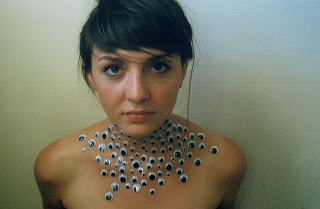REVIEW: Julia Easterlin, Knower, Safiyyah Johnson @ Isabella Stewart Gardner Museum 12/08

Photo by Tammy Jean Lamoureux
RISE is the new evening concert series at Boston’s Isabella Stewart Gardner Museum. It’s a program dedicated to showcasing the talent of young, up-and-coming artists. Their Thursday night show on Dec. 8 did just that. With the three captivating acts of Julia Easterlin, Knower, and Safiyyah Johnson, and an attentive crowd, the atmosphere was perfect for a museum concert.
The night concert, which took place in the architecturally stunning RED concert room, began with a performance by Safiyyah Johnson, a high school senior studying vocal jazz at the Boston Arts Academy. She performed an emotional cover of Jessie J’s “Who You Are.” Her age was no hindrance to her talent and maturity. She tackled Jessie J’s vocal feats of the song with ease and showcased natural talent. She played piano during the song with force that filled the room. Johnson’s performance was the perfect opening to RISE; it was a display of youth and passion that inspired audience members to think of the importance of young artists.
With Betty Who’s cancellation of her originally scheduled performance at the Isabella Stewart Gardner, the RISE show was attended by only an enthusiastic few. Many seats were left empty, but those in attendance greeted each artist with interest and attention. The hosts and curators, Shea Rose and Simone Scazzochio, made the crowd feel welcome and excited, speaking of their personal passions for those on the bill. Their hosting was a show of fervor I rarely see at concerts, and contributed to the intimacy, bonding, and artistic flair of the experience.
The next act was Knower, an LA duo who turned RISE into a party. An electronic dance group, Knower is comprised of drummer/producer Louis Cole and vocalist Genevieve Artadi—together a team of eccentric buddies. For the concert, both stood in front of a giant screen, which broadcasted the group’s hilarious videos of dancing skeletons and phallic airplanes crashing into McDonald’s. Artadi danced and sang, and Cole provided the various beats using a laptop, synth, and sometimes even a real drum set. The group came across as being excellent party hosts rather than performers, pausing often to joke with the intimately-sized crowd and to invite audience members to stand and dance with them. Videos of McDonald’s being destroyed were met with good-natured laughter from the crowd.
After the second act, the crowd and I were feeling ready for the club or maybe some trick-or-treating. The emotional power of the opener met with the high energy of the second act had me curious about the third and final performer. I was skeptical, as I’m sure most were, of who could top the last group, who had been chosen to replace Betty Who, and why they had been chosen. I read the artist’s bio provided by the museum and found myself put off by the inclusion of the story of the artist’s spiritual journey around the world, rather than an explanation of her musical style. As an impatient, information-hungry millennial, I was further aggravated when Julia Easterlin first took the stage at a slow pace.
When Easterlin made her way to the center of the room, she chose first to speak about herself and putting on makeup moments before entering the room. I thought this was a rookie move when she said to the audience, “Can you imagine, covering my own face,” then going on to talk about her day prior to the show. I was not used to seeing performers begin a set with an anecdote, and I was turned off by Easterlin’s chat. If the rest of the performance continued like this, I would have been upset, but luckily it didn’t at all. When she began to perform, things made sense.
As a looping artist, Easterlin proved enormously skilled at using her body as the main musical device. While clearly having a credible strength at making various sounds with her vocal chords, she showed that this was nothing like Boston University’s acappella shows. Instead, Easterlin was solo, making all the the sounds herself on the spot. She took off her shoes and used her bare feet to create drum beats on the floor. She layered incredibly subtle clicks and tones of her voice to create sounds within a song that would seem almost indecipherable. But Easterlin knew exactly what she was doing, or gave the impression of so. What was most impressive about her live-action musical performance was the confidence with which she performed. Her voice, at first seeming light, proved to be immensely rich and powerful. Her looping skills were perfectly timed and practiced. Seeing this one women create music in this way was like seeing into an artist’s mind, making the performance all the more vulnerable and intimate.
There were plenty of reasons for me and the rest of the attendants to have low expectations for the concert that night: Betty Who’s cancellation, the low number of people in the crowd, and the, at first, seemingly random variety of performers in musical style. But all of those factors proved advantageous to the night. The diversity of performers and small audience size contributed to a night of intimate audience support and thought-provoking music.
-Allie Miller